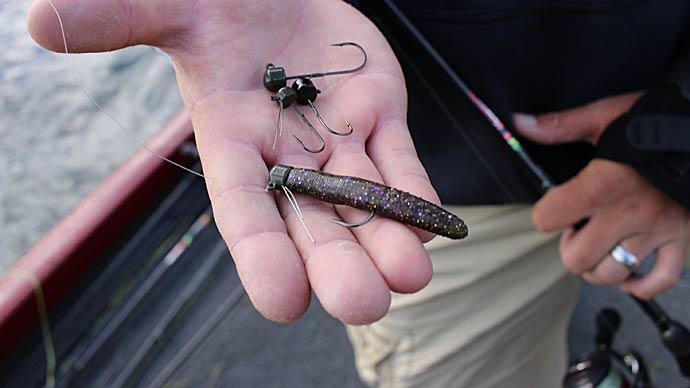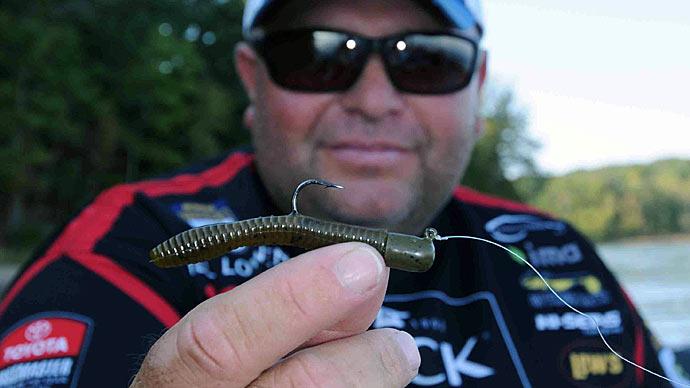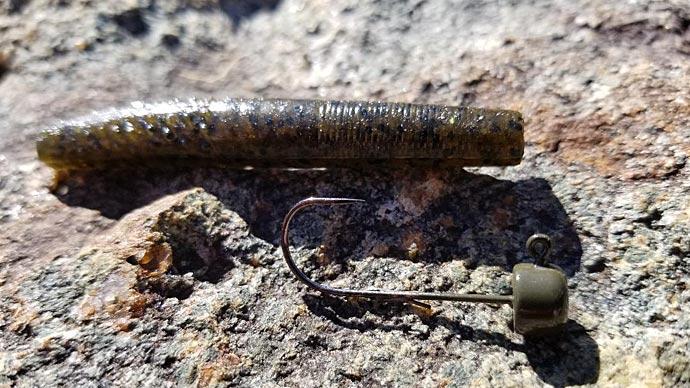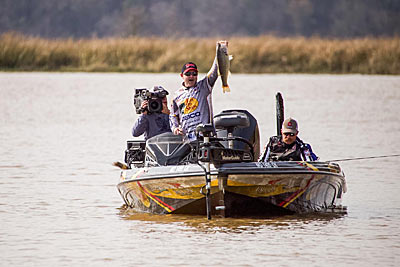
The Ned Rig, aka the Midwest Finesse Rig, is simple: it’s just a piece of a Senko-like bait rigged on a small jig that will allow it to stand up on the bottom. Back in the day, we had a similar rig: the Shaky Head, and special shaky head jigs quickly hit the market. It was called a Shaky Head because that’s how you fished it – just shaking it in place. The original Westy Worm was like the Ned Rig and the Shaky Head. Because it was made with super floater worms and lightweight hooks, the bait stood up on the bottom even though it was up to six inches long. Baits that are not floaters will overpower the jig and fall over, hence the reason for the tiny baits on the Ned Rig.
The biggest drawback for most of these rigs is the open hook. Fished around submerged wood or grass, weeds, or even some of the jagged rocks you find underwater out west, those open hooks quickly get stuck. But these little rigs are hard to beat for open water presentations during tough times. “Over the past few years, finesse has found its place,” says MLF pro Mike McClelland, “not just for weekend anglers, but on the tournament trail as well. At first, we all threw trick worms, using the jig heads already out, but lately, some new heads have come out that allow us to fish finesse baits in lots of applications.” Those old jig heads, he said, often had hooks that were too big for the application.
The Gear
Typically, he fishes a Ned Rig on a spinning rod: a medium action Falcon rod called the Finesse Jig Spinning Rod. He uses 8- to 10-pound-test Sunline FX Braid with a 5- to 8- or even 10-pound-test Sunline fluorocarbon leader. He uses an FG knot to join the two kinds of line. “I’ve tried every connection knot,” says McClelland, “and this one is the best. It can be challenging to tie, I admit, but it is worth the trouble to learn.” (You can do a quick web search for videos on how to tie the FG knot).
Mike says he likes an “excessively long leader” – eight to twelve feet long, to be exact. He wants enough leader to allow the fluorocarbon line to be on the spool when he hooks a fish. Also, a very long leader can break off several times before he has to tie another leader on. To tie the jigs to the fluorocarbon, he uses a knot that he and Gerald Swindle came up with: the California Knot, or some call it the San Diego Jam. It’s an improved clinch knot with a doubled line – when you cut the excess line off, you have three tag ends.
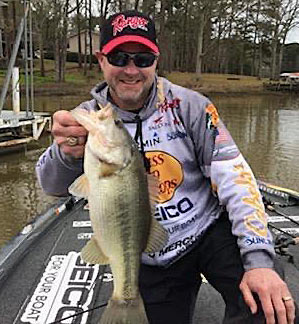
Open Water Finesse Jig Heads
For McClelland, midwestern lakes like Beaver Lake, Table Rock, and Bull Shoals are the perfect place for a Ned Rig, with their deep clear water, lots of gravel, and very little vegetation. These baits shine on lakes like these, he says. For places like these, where he isn’t fishing a lot of cover, Mike likes the new Gamakatsu Finesse Jig Head with the spring lock keeper. “I like the open hook when I’m not covered because it allows for better hook-up ratios and ease of penetration. The spring lock keeper is perfect for little Big Bite Finesse worms or Big Bite Ned Worms.” The spring lock head has a light wire #1 hook that is perfect for small baits.
Mike will also fish Big Bite Grubs and even small 2.5 – 2.8” swimbaits on these heads – but he swims them in open water. The big debate with grubs is always about tail up or tail down, and Mike says they all swim differently depending on the tail itself. So he plays with them both ways and then decides. He wants grubs to swim as level as possible, and turning the tail can change the angle. But mostly, this jig head is the one he chooses for Ned Rigs, which he says is a better version of the Shaky Head. This little spring lock jig comes in three sizes so that he can fish different depths with the same little worm. He uses the 1/16 for shallow fishing, the 1/8 for a little deeper or windy days, and the 3/32 when he needs to get the bait down fast.
“When I fish a Ned Rig, I’m trying to make as many presentations as possible in high percentage areas,” he says. In clear water, you can see a color change that signals rocks or deep spots, and he throws to these kinds of targets, shakes the bait a time or two, then reels it right in. Most of the time, he does not fish the bait back to the boat. He can cover a lot of water quickly and efficiently, wasting very little time or energy on non-productive areas.
Finesse Jig Offset
One of the best things about the new Gamakatsu Finesse Jig Offset is that the offset eye is countersunk into the jig head, which means the knot is protected, so you spend a lot less time tying on and a lot more time fishing. Since you can rig the little baits Texas on this jig, it is much more versatile in all kinds of places, says Mike. He’ll grab this rig when he comes to scattered vegetation and little grass clumps – not thick stuff, but the occasional clump. He’ll spend more time fishing this jig head on a spot than the open hook and fish it a little deeper. He still doesn’t spend much time in a single spot, just a bit of time.

This bait is weedless because of the Texas rigging, so he can throw it in places where he couldn’t throw the open hook. He also throws small swimbaits on this jig head. When he rigs a bait on this head, he pushes the hook all the way through and then barely puts the point back under the skin of the bait. That way, it’s still easy to set the hook but remains weedless. To set the hook with any of these little baits, he says to reel it in – you don’t have to hit it hard, even with a Texas rig. Just reel a little faster, then sweep. He never jerks it. The fine wire 1/0 hooks penetrate pretty much effortlessly. To detect a bite, watch for a subtle jump or bowing of the line or sideways movement. You don’t always feel the bite, so you must pay attention.
Bottom Knocker Offset Jig
Because this jig is a modified tiny football head, you can drag it on the bottom. It comes in slightly larger sizes: 3/8, 1/2, 5/8, and ¾-ounce, all with 1/0 hooks. These little jigs are perfect for fishing small baits deep, says Mike, making them killer on smallmouth and spots and largemouth bass. When the fish on big water lakes reach twenty-five to forty-five feet deep, but the water is still clear, you must throw finesse baits. The trick is to get those small baits down to deep fish efficiently, and these little jigs are ideal. He says the Big Bite College Craw is the perfect bait for this little jig head. He sticks to his spinning gear for the smaller sizes, but for the bigger ones, he sometimes switches to a medium-heavy Falcon baitcaster.
He throws it out to fish this jig and keeps it in contact with the bottom, targeting things like pea gravel points, rock ledges, etc. He drags it around just like he would a Carolina Rig, keeping it at a certain depth. The shape of this little jig naturally puts a bit more action to the bait -- it rolls back and forth a tiny bit and adds action without him having to twitch or hop the jig.
Added Attraction
McClelland does use scent whenever he is finesse fishing because, generally, the fish are more finicky. Otherwise, you wouldn’t have to finesse them, right? He uses all kinds of different scents, and he likes to keep a little spray bottle up front that is a mix of several different scents. He picks it up and gives his baits a little spritz now and then. Ditto with dye. He doesn’t have a particular brand that he likes, but he has noticed that sometimes dipping the tail of a bait in some dye can make a difference in how many bites you are getting on it. He finds that summer is the time he uses finesse baits the most, so he’ll be stocking up on jig heads now.
Whether you call it a trick worm, a shaky head, a Ned rig, or just a jig, a small bait on a small jig can put big fish in the boat. The technique is only as good as the jig, so grab a handful of quality jigs and give some of these techniques a try this summer.
Find out more about Mike McClelland at http://www.mikemcclellandfishing.com.
BassResource may receive a portion of revenues if you make a purchase using a link above.


